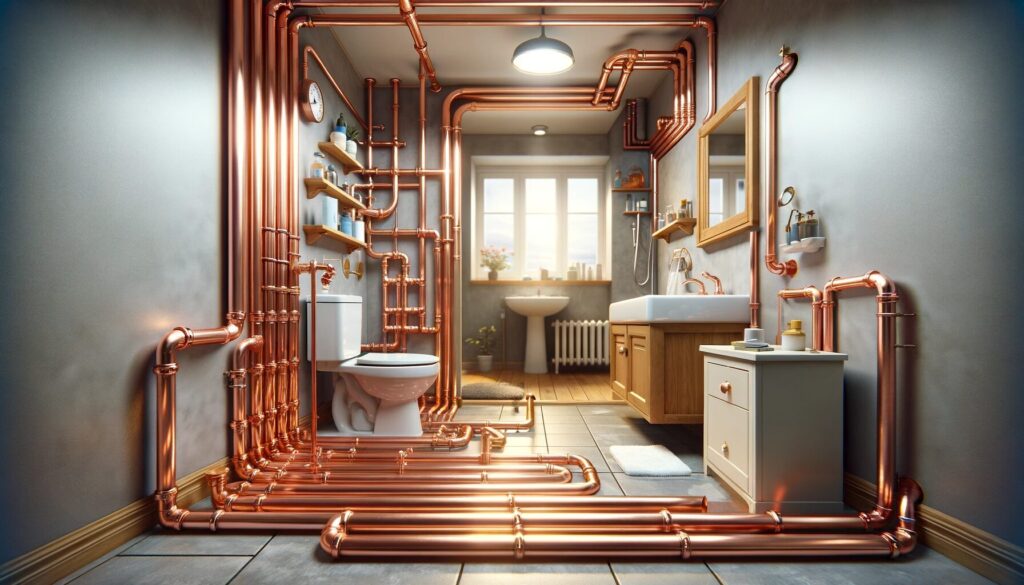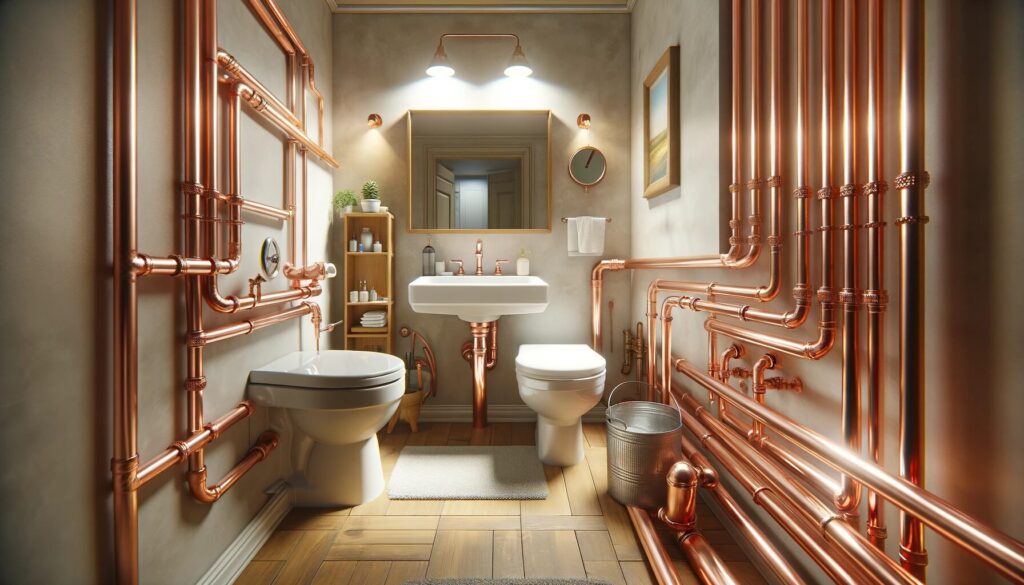Let’s dive straight into the heart of your home’s plumbing system: copper pipes. Their maintenance is as crucial as the foundation of your house. Both DIY enthusiasts and professional builders need to grasp the significance of these pipes. They’re not just conduits for water, they’re the arteries of your home’s plumbing system.

Understanding Copper Pipes
Copper is the unsung hero in the world of plumbing. It’s resilient, versatile, and has been a staple in the trade for years. Here’s what makes copper stand out:
- Durability: These pipes are in it for the long haul. With proper care, they can last decades.
- Thermal Conductivity: Perfect for both hot and cold water supply, copper efficiently handles temperature changes.
- Health Benefits: Copper is naturally resistant to bacteria and doesn’t allow harmful substances to seep into your water supply.
Signs Your Copper Pipes Need Cleaning
Your copper pipes will show signs when they need attention. Just like a well-oiled machine shows signs of wear, these pipes have their way of signaling for help.
Identifying the Red Flags:
- Tarnish: A discolored or darkened pipe is a clear indicator. This tarnish is the beginning of a process that can lead to more serious issues.
- Corrosion: It’s more than just an aesthetic issue. Corrosion can weaken your pipes from the inside, leading to leaks or even bursts.
- Water Pressure and Flow Issues: A noticeable drop in water pressure often points to buildup or blockages in your pipes, impeding the flow.
The Risks of Ignoring the Signs:
- Leakages: Small leaks can quickly escalate into major water damage.
- Clogs and Blockages: Like arteries clogged by cholesterol, pipes can get blocked, leading to backups and plumbing nightmares.
- Compromised Water Quality: Letting your pipes go unattended can result in water that’s not just unpleasant but potentially unhealthy.
Proactive Maintenance:
The key is in regular check-ups and cleaning. It’s not just about fixing problems as they arise, but preventing them in the first place. A proactive approach will ensure your copper pipes continue to function optimally and last longer.

Materials and Tools Needed
In the world of copper pipe maintenance, the right materials and tools are your best allies. Based on years of hands-on experience, I’ve learned that simplicity and quality are key. Here’s what you’ll need:
- Copper Polish: A quality copper polish is essential. It’s like the right seasoning for your favorite dish – it brings out the best.
- Natural Cleaners: Household items like vinegar, salt, and lemon aren’t just for your kitchen, they’re incredibly effective for cleaning copper.
- Soft Rags and Brushes: You’ll need non-abrasive brushes and soft rags. Think of them as gentle tools for a delicate job.
- Safety Gear: Never forget your gloves and goggles. Safety is paramount in any renovation task.
Step-by-Step Guide to Cleaning Copper Pipes
With the right tools in hand, let’s walk through the steps. This guide is about practical, tried-and-tested methods that work.
1. Basic Cleaning
- Routine Maintenance: For light tarnish, mix vinegar and salt, or use your copper polish. It’s like preventive medicine for your pipes.
- Gentle Application: Apply the mixture using your brush or rag in smooth, circular motions – akin to polishing a cherished piece of furniture. Rinse and dry thoroughly.
2. Deep Cleaning for Tarnished Pipes
- For Stubborn Tarnish: When tarnish is deeply set, a more robust approach is needed. Create a paste using vinegar, salt, and flour, or opt for a commercial copper cleaner.
- The Cleaning Process: Apply the paste, let it sit, then scrub gently yet firmly. It’s similar to restoring a vintage piece – patience and care are essential. Rinse well afterwards.
3. Polishing Copper Pipes
- Restoring the Shine: After cleaning, apply copper polish to bring back the luster. It’s akin to putting the final coat of paint on a well-crafted piece.
- Final Buffing: Use a clean, dry rag for the last buff. This step is like the final sweep of the broom after a day’s hard work – satisfying and essential.
4. Preventive Measures
- Regular Checks: Frequent inspections and light cleanings are the cornerstone of copper pipe maintenance. It’s about being proactive rather than reactive.
- Routine Upkeep: Think of it as the regular tune-up for your car, necessary for smooth operation and longevity. A consistent maintenance schedule is the best way to avoid future problems.
Safety Tips
In the realm of copper pipe maintenance, safety is paramount. It’s not just about getting the job done, it’s about doing it safely and smartly.
- Wear Protective Gear: Always wear gloves and safety goggles. This is non-negotiable. Chemicals, even those that are naturally derived, can irritate your skin and eyes.
- Ensure Good Ventilation: Work in a well-ventilated area, especially if you’re using stronger chemicals. It’s about protecting your respiratory health.
- Careful Product Use: Read labels thoroughly. Understanding the product you’re using is crucial for safe and effective use.
- Maintain Your Tools: Keep your brushes and rags in good condition. A frayed brush or a ragged rag can cause scratches and potentially damage the pipe surface.
Troubleshooting Common Problems
In every renovation project, you’re bound to encounter challenges. Here’s how to address common issues with copper pipes.
- Tackling Stubborn Stains: For stains that refuse to budge, use a paste of vinegar, salt, and flour. It’s a more potent mixture that can break down tough stains. Apply, let it sit, then gently scrub.
- Dealing with Discoloration: Discoloration can often be remedied with lemon juice, a natural acid that’s effective yet gentle on copper.
FAQ Section
Opt for a gentle approach. Use soft rags, non-abrasive brushes, and mild cleaners. Treat your pipes as you would a delicate surface, with care and patience.
Yes, natural ingredients like vinegar, salt, and lemon can be highly effective. They’re environmentally friendly and gentle on the pipes while being tough on tarnish.
Regular maintenance is key. Aim for a light cleaning every few months to keep tarnish at bay and maintain the integrity of the pipes.
Look for persistent cracks, deep corrosion, or continuous leaks. These are indicators that the pipe may be beyond repair and could require replacement by a professional.
